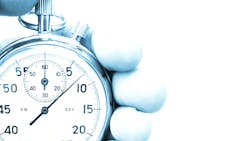4 time management tips for dental hygienists: The race against the clock
Originally published in 2021 and updated regularly.
It's 10:05 a.m., and your patient was due at 10. Every bone in your body wants to immediately call them and ask where they are. The business team will often wait until 10 minutes into an appointment to call a patient, who then says they’re “pulling into the parking lot now.” Yet they don’t walk into the office until 10:15 a.m., and of course they need to use the restroom.
We’ve all been through this, probably more often than we’d like to admit. As a new grad, it can feel impossible to recover from this situation. It’s easy to fall behind in our day after a 15-minute delay. Plus, if we fall behind, we can lose credibility with our patients.
I've become a time management expert during my years in clinical hygiene. I'm excited to share four tips to improve your time management skills so that when a patient or the doctor runs behind, you can take control of your schedule.
Preaudit your charts
Determine what patients will need that day. Every patient 18 and older needs a full periodontal chart once a year, and patients who are periodontally involved need a periodontal chart every three months. Depending on the information dictated, collecting a comprehensive periodontal chart can take five to eight minutes via voice dictation.
Patients need an updated medical history every year. If a patient has a complex medical history, this can take them five to eight minutes to fill out, so you'll need to plan accordingly. Identify what the patient needs for films, such as an FMX. An FMX can take anywhere from eight to 15 minutes depending on the patient's tolerance and compliance when placing the digital sensor. Each of the services the patient needs during an appointment should be listed on the appointment book. This list will enable the team to assist you if you run behind.
Success leaves clues
Mark Hyman, DDS, is a dear friend and mentor, and he consistently reminds dental professionals about our notes—treatment notes should be detailed enough so that any clinician can pick up where we left off. I love to check on the home care recommendations I made at the previous visit to reinforce the importance and proper use of a product.
I highly recommend using note templates for patients. I have one for periodontal maintenance, sealants, pediatric hygiene visits, prophy patients, and scaling and root planing. This saves time and allows your notes to be very comprehensive without needing hours to dictate.
A comprehensive note will determine what series of appointments are needed to treat a patient. For instance, if the patient needs multiple restorations, the visits should be broken down into appointments such as NV1 and NV2. Completing comprehensive notes will allow you and the team to streamline your patient communication and expedite collecting information based on the patient's chief concern and risk assessments.
Set up ahead of time
An effective way to stay on time is to make trays ahead of time. This allows you to have everything you need on the tray and ready to go. You can take the dirty instruments and tray to the sterilization area if you’re running behind. In a perfect world, a team member will help you complete the sterilization process. Then you can focus on decontaminating the room and simply grabbing a premade tray with the sterilized cassette and armamentarium for your next patient.
The 20-minute rule
If you’re scaling more than 20 minutes, it is not a prophy. During the first 20 minutes of the appointment, the medical history, oral cancer screening, periodontal charting, and films should be collected. This will allow you to determine if the patient is a gingivitis patient, periodontally involved patient, or healthy. Then you can determine the treatment plan.
If the patient arrives 20 minutes late, the appointment time should be used for an assessment. The patient should be called back in for hygiene therapy. If they’re 20 minutes late, you’ll update the medical history, oral cancer screening, periodontal charting, and films only. Many hygienists rush through the appointment and skip assessment tools such as oral cancer screening. After all, we think, the patient ran late and we shouldn’t be penalized for their tardiness.
It’s important to focus on the things we can control. Implementing these time management skills will reduce stress in practice. When we show up less stressed, there is room for more confidence. Not only do our patients love confidence, so do our employers. A confident employee is often a happy employee. Happiness is contagious, and patients want to be treated by a happy dental hygienist!
About the Author

Amber Auger, MPH, RDH
Amber Auger, MPH, RDH, is an international lecturer, 2019 Sunstar/RDH Award of Distinction recipient, and creator of Thrive in the OP and the certified Functional RDH. With more than 24 years in the dental field and practicing hygiene since 2010, Amber empowers professionals through on-demand courses and coaching. She specializes in root-cause soft tissue management, practical protocols, and career development, inspiring clinicians to enhance patient care and achieve career satisfaction. Reach Amber at a[email protected].
